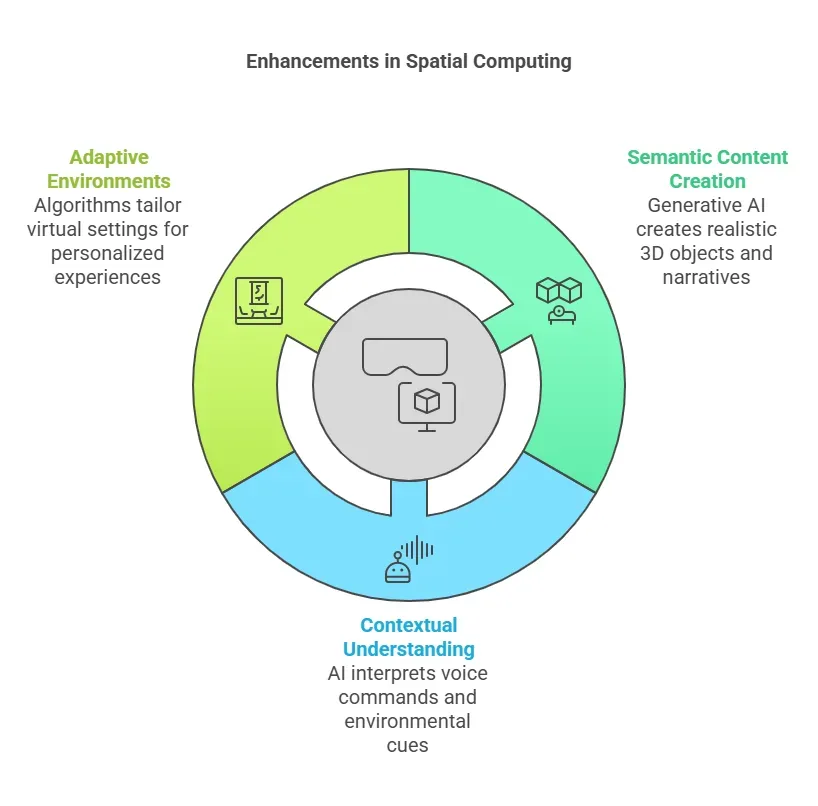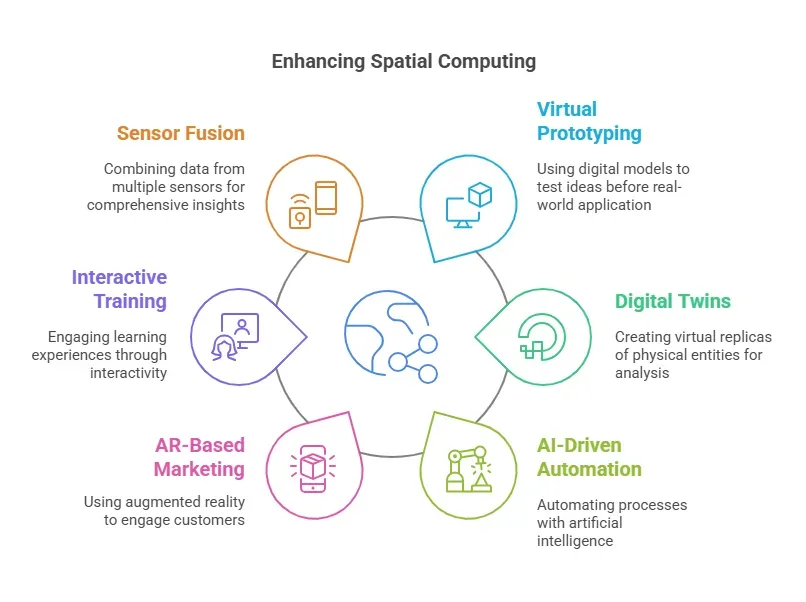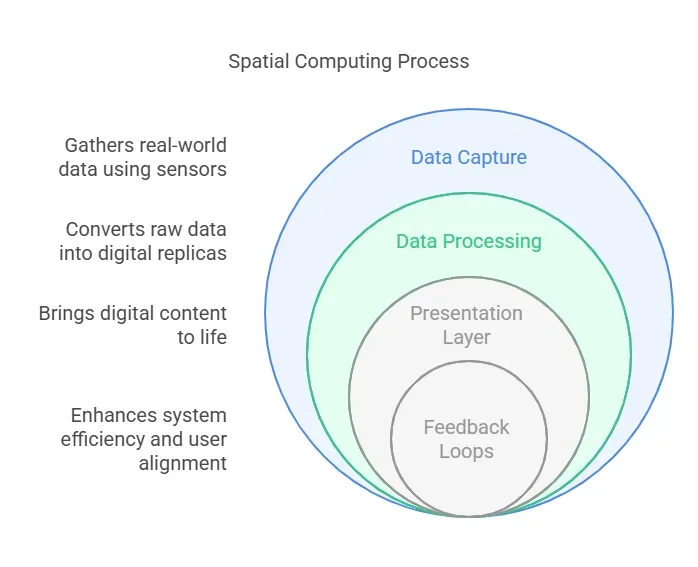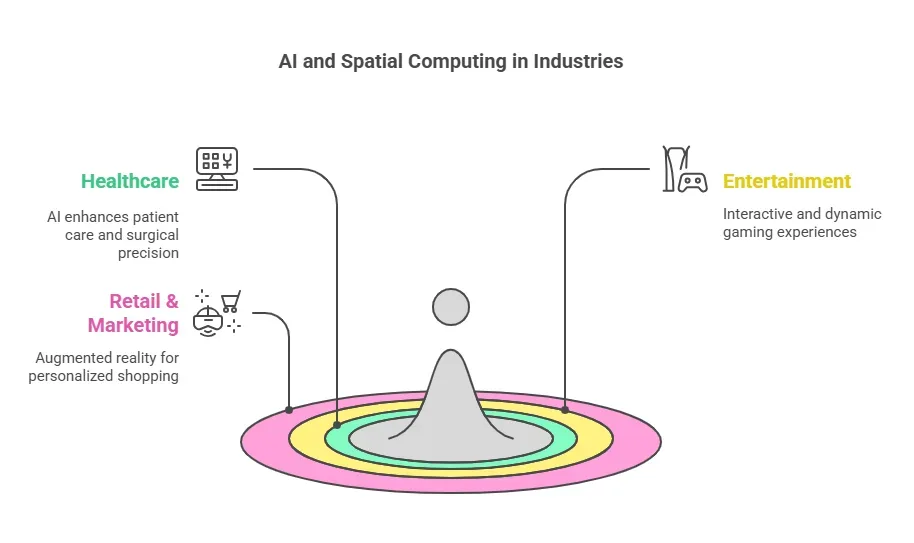Spatial computing isn’t just another tech trend—it’s a revolutionary convergence of real and virtual worlds that opens new frontiers for businesses and consumers alike. By integrating generative AI and NLP (Natural Language Processing) into spatial computing solutions, organizations can create smarter, more adaptive environments that truly understand users’ intentions. In this comprehensive pillar piece, you’ll discover the technology’s core principles, advanced applications, and potential to reshape entire industries.
Understanding Spatial Computing

Spatial computing merges sensors, AI-powered analytics, and immersive content to produce environments that feel both digital and real. From wearable devices (like AR glasses or VR headsets) to interactive platforms powered by machine learning, this technology transforms static data into dynamic, context-aware experiences.
How Generative AI Enhances Spatial Computing
- Semantic Content Creation: Generative AI helps develop realistic 3D objects, interactive narratives, and on-demand simulations.
- Contextual Understanding: By harnessing NLP, spatial systems can interpret voice commands, environmental cues, and user intent more accurately.
- Adaptive Environments: Intelligent algorithms can rapidly tailor virtual settings, making each user’s experience more relevant and personalized.
Core Benefits and Use Cases

- Enhanced Efficiency: Virtual prototyping and digital twins reduce trial-and-error, saving time and resources. With AI-driven automation, teams can test hypotheses virtually before acting in the real world.
- Immersive Engagement: AR-based marketing, interactive training modules, and location-specific content hold user interest. Generative AI further elevates these experiences by crafting personalized, real-time visuals and storylines.
- Improved Decision-Making: Sensor fusion and analytics supply up-to-date data, enabling better insights. NLP-fueled dashboards can interpret voice or text inputs, giving decision-makers instant answers.
- Cross-Industry Adoption: From healthcare to manufacturing and education, nearly every sector has found a beneficial use for spatial computing. Generative AI extends these possibilities by predicting user needs and accelerating content creation.
How Spatial Computing Works

- Data Capture: Sensors (LiDAR, GPS, cameras) gather real-world data. Generative AI models can supplement this by simulating hypothetical scenarios.
- Data Processing: Machine learning and 3D modeling convert raw inputs into digital replicas. AI algorithms refine those replicas in real time, making them more accurate and lifelike.
- Presentation Layer: AR/VR devices, mobile apps, or spatially aware dashboards bring content to life. Generative AI can dynamically inject new elements—like virtual assets or real-time text overlays—based on user context.
- Feedback Loops: Real-time analytics and user interactions shape system improvements. With deep learning, each iteration becomes more efficient, intuitive, and aligned with user needs.
Deep Dive: Clusters of Spatial Computing
Below, we break down six core areas of spatial computing, each influenced by AI advancements. Click through for deeper insights.
AR & VR Innovations
Augmented Reality (AR) and Virtual Reality (VR) remain the most recognizable facets of spatial computing. With generative AI, these immersive spaces can feature:
- Real-Time Content Generation: Dynamic environments that respond to user behavior.
- Adaptive Training Modules: VR courses tailored to an individual’s learning pace.
Explore More: AR & VR Innovations
Digital Twins and Real-World Simulations
Digital twins replicate physical systems in digital form. When combined with generative AI:
- Predictive Analysis: Anticipate equipment failure or user interactions by simulating infinite variations.
- Cost-Efficient Prototyping: Test new ideas virtually and roll out optimized versions.
Explore More: Digital Twins & Real-World Simulations
Geospatial Analytics and Location-Based Services
Geospatial data gains even greater nuance with AI:
- Intelligent Routing: Real-time route adjustments powered by generative AI predictions.
- Urban Insights: AI can detect traffic patterns or environmental risks before they emerge.
Explore More: Geospatial Analytics & Location-Based Services
Industry-Specific Applications

Spatial computing, amplified by AI, is revolutionizing many sectors:
- Healthcare: Personalized patient monitoring, AI-assisted surgical navigation.
- Entertainment: Interactive shows and gaming scenarios generated on the fly.
- Retail & Marketing: Hyper-personalized AR product recommendations.
Explore More: Industry-Specific Applications
Security, Privacy, and Ethical Considerations
Collecting detailed spatial data and using AI to process it necessitates robust safeguards:
- Ethical Data Usage: Maintain compliance with data protection laws.
- Transparent Algorithms: Employ explainable AI methods to build user trust.
Explore More: Security, Privacy, and Ethical Considerations
Future Trends and Emerging Tech
Innovations like 5G, edge computing, and generative AI pave the way for:
- Seamless Mixed-Reality Environments: Lower latency and faster rendering.
- Advanced Computer Vision: Automated object recognition and scene understanding.
Explore More: Future Trends and Emerging Tech
Conclusion
Spatial computing, bolstered by generative AI and NLP, is transforming our approach to design, collaboration, and problem-solving. Whether it’s immersive entertainment experiences or predictive digital twins, the fusion of AI and spatial technologies helps businesses, institutions, and individuals alike stay ahead in a rapidly evolving digital landscape. By exploring the clusters linked here, you’ll gain both a high-level overview and the granular detail needed to harness spatial computing’s transformative power.
FAQ
Q1: Is spatial computing only about AR and VR?
A: While AR and VR are standout elements, spatial computing also encompasses geospatial analytics, digital twins, and sensor-fusion—especially when integrated with AI.
Q2: How do generative AI and NLP fit into spatial computing?
A: Generative AI can create real-time 3D elements, simulate user scenarios, and interpret queries via NLP. Together, they bring richer interactivity and personalization.
Q3: Which industries benefit most from spatial computing?
A: Healthcare, manufacturing, retail, education, and entertainment see major gains, with AI-driven automation and analytics further expanding use cases.
Q4: Are there ethical concerns with AI-driven spatial computing?
A: Absolutely. Data privacy, consent, and algorithmic fairness are critical. Organizations must maintain transparency and follow data protection regulations.
Q5: What’s next for spatial computing?
A: Expect deeper integration with 5G, edge computing, and advanced AI models, driving more interactive, context-aware applications across virtually every sector.








6 thoughts on “Spatial Computing & Generative AI: Transforming the Future of Digital Experiences”